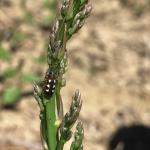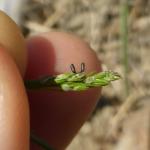Asparagus Beetle, Common
Crioceris asparagi
There are two beetle pests of asparagus, the common asparagus beetle and the spotted asparagus beetle. Distinguishing between the two species is important because while both beetles can damage the emerging spears, the common asparagus beetle larvae and adults can also devour the ferns. Significant defoliation can weaken the plant and reduce the plant’s ability to provide sufficient nutrients for the following season. Serious defoliation can also make asparagus more susceptible to invasion by plant pathogens. The feeding of spotted asparagus beetle larvae on berries does not affect the health of asparagus plants over the long run.
Identification:
Common asparagus beetle is blue-black, shiny, smooth and 6-9 mm (⅜ inch) long. The most distinctive markings are three large cream-colored, squarish spots with red margins along each wing cover. The head, legs and underside are blue-black, and the thorax is reddish. Eggs are dark brown, laid standing on end in rows along the spears, with 3-10 in each cluster. Larvae are wrinkled, plump, hump-backed, and dull gray or brown with black head and legs. They go through four growth stages (instars) and grow up to about 8 mm (⅓ inch). Pupation occurs in the soil, and pupae look similar to adults except for yellowish coloration.
Life Cycle:
Adult beetles overwinter in field borders or within asparagus fields. Sheltered sites such as under bark or in the stems of old plants are preferred. Some burrow into the soil. Adults emerge in early May and colonize asparagus fields to mate, feed, and lay eggs. Eggs hatch in 3-8 days, depending on temperature. Larvae feed in spears and ferns, and when mature, drop to the soil to pupate. There are 2-3 generations each season, with the first generation producting the most eggs. Second generation larvae feed in ferns. The temperature threshold for larval development is 10°C (50°F). In September, new adults search for overwintering sites.
Crop Injury:
Adult feeding on spears causes scarring and browning. Presence of eggs and feeding damage can render the crop unmarketable. Both adults and larvae feed in ferns and can reduce the plant's ability to build resources for a strong crop the following spring. Damaged plants are also more susceptible to infection by the fungal pathogen, Fusarium.
Monitoring & Thresholds:
Begin scouting early in spring and continue through the summer. Scout for adults on sunny afternoons, when beetles are more active. Scout by sampling 10 plants in each of 5-10 different locations. Beetle distribution across the field tends to be clumped. Count adults, eggs, larvae, and take note of the damage to each plant. Consider treatment if >10% of the spears are infested with beetles (1 or more per plant) or 1-2% have eggs or damage. Treat ferns if 50-75% are infested.
Cultural Controls & Prevention:
- During harvest, harvest all spears every day to reduce the number of stems where eggs will survive for long enough to hatch or where larvae can feed and grow into summer-generation beetles.
- Disk old ferns lightly in the fall and clean up crop edges to reduce overwintering sites.
- Maintain clean environment in asparagus fields in the fall to force adults to overwinter in field edges where natural predators reside.
- Allow plants in one area to develop ferns so as to act as a trap crop. These plants can then be sprayed selectively.
Chemical Controls & Pesticides:
Daily harvest of asparagus makes chemical treatment difficult. 1 dh products are available and can be used immediately after picking to allow harvest the following day (see the New England Vegetable Management Guide for current recommendations) although some growers seek to avoid applications during harvest. More selective products may be used on fronds after harvest.
Organic options on spears include Surround WP as a repellent, EC5.0, or products containing capsaicin (check for certification status).
If possible spot spray along edges of planting where overwintering adults colonize the field and/or band insecticide over the row to help spare natural enemies. Use selective insecticides on ferns.
Biological Control:
The most important natural enemy of common asparagus beetle is a tiny parasitic wasp (Tetrastichus asparagi) that attacks the egg stage. Wasps kill eggs by feeding on them. These parasitoids also lay their own eggs inside the beetle eggs. The immature wasps grow inside the beetle larvae, killing them when they pupate. Studies have found >50% of eggs killed by feeding and half of the surviving larvae parasitized. Providing a nearby nectar source such as umbelliferous flowers may enhance wasp populations.
For current information on production methods (including varieties, spacing, seeding, and fertility), weed, disease, and insect management, please visit the New England Vegetable Management Guide website.
Crops that are affected by this insect:
Sources:
Handbook of Vegetable Pests by John Capinera; 2008-2009 New England Vegetable Management Guide; Eric Sideman, MOFGA; Brian Caldwell, Cornell Universtiy, Suzanne Wold-Burkness and Jeffrey Hahn, UMI Department of Entomology.
The Center for Agriculture, Food and the Environment and UMass Extension are equal opportunity providers and employers, United States Department of Agriculture cooperating. Contact your local Extension office for information on disability accommodations. Contact the State Center Director’s Office if you have concerns related to discrimination, 413-545-4800 or see ag.umass.edu/civil-rights-information.


